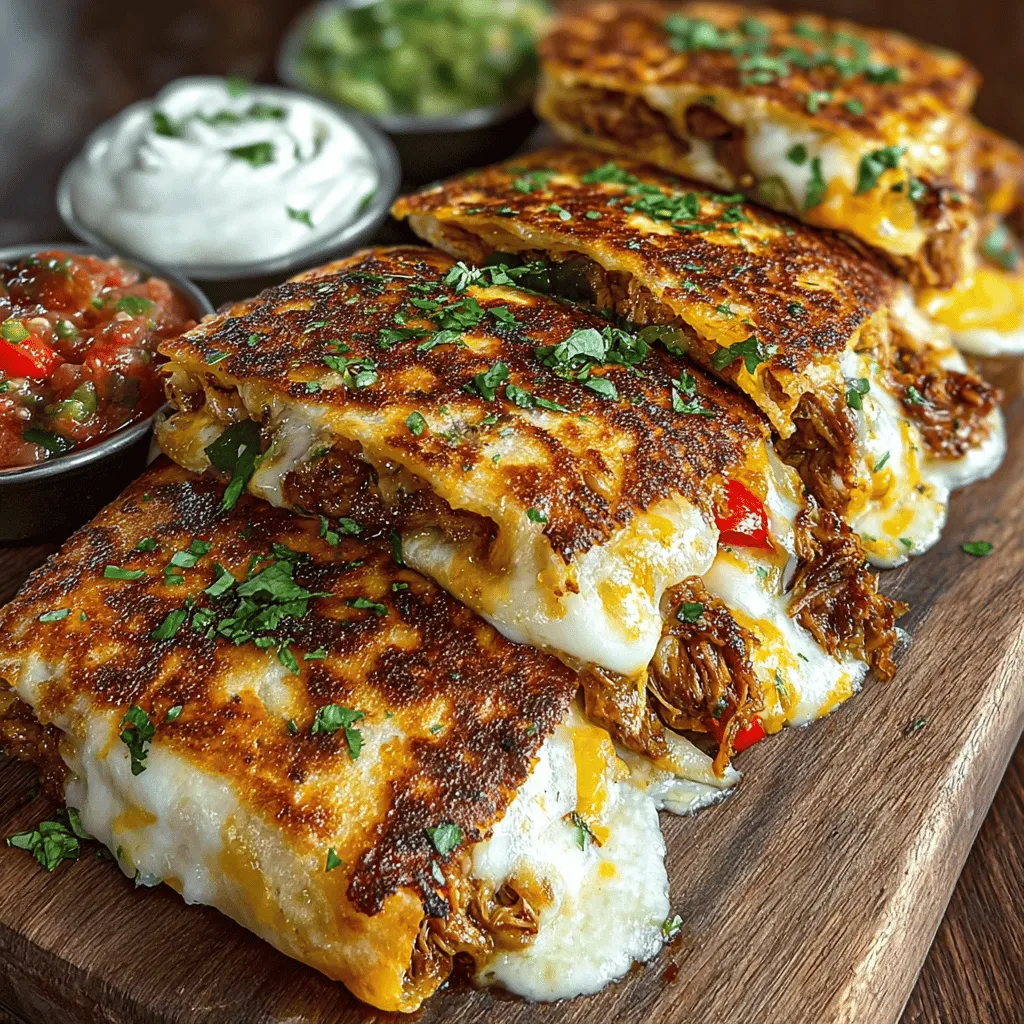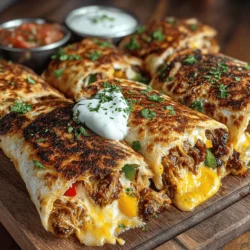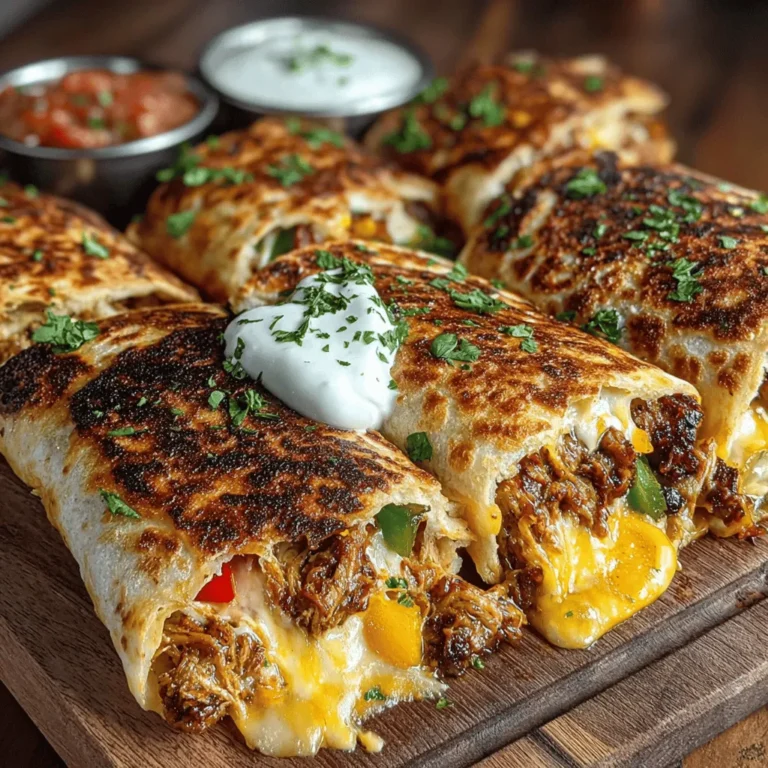Introduction: The Allure of Chicken Fajita Quesadillas
Delightfully crispy, flavor-packed, and incredibly satisfying, Chicken Fajita Quesadillas are a culinary masterpiece that masterfully combines the vibrant flavors of Mexican cuisine into a convenient, easy-to-make format. This dish is more than just a meal; it’s an experience that brings friends and family together around the dinner table. Whether you’re facing a hectic weeknight, planning a casual gathering, or simply looking to satisfy a lunchtime craving, Chicken Fajita Quesadillas stand out as a versatile option that never disappoints.
The beauty of Chicken Fajita Quesadillas lies in their adaptability. They can be customized to suit your taste preferences or dietary needs, making them a crowd-pleaser for both adults and children alike. The crispy exterior of golden-brown tortillas wraps around a delicious filling of marinated chicken, sautéed vegetables, and gooey cheese, creating a tantalizing blend of textures and flavors that is hard to resist.
In this blog post, we will delve into the enticing world of Chicken Fajita Quesadillas, guiding you through the essential ingredients, preparation techniques, cooking strategies, and presentation tips to ensure your dish is as visually appealing as it is delicious.
Understanding the Ingredients
Exploring the Flavor Profile of Chicken Fajita Quesadillas
To create a truly flavorful quesadilla, understanding the role of each ingredient is crucial. The combination of protein, vegetables, spices, and cheese forms the backbone of this dish, each component contributing to the overall flavor profile.
The Role of Chicken: A Protein Powerhouse
Chicken is the star of Chicken Fajita Quesadillas, providing a lean source of protein that not only adds substance to the dish but also absorbs the rich spices and flavors of the marinade. Opting for boneless, skinless chicken breasts or thighs can enhance the juiciness of the filling, ensuring each bite is tender and succulent. Marinating the chicken prior to cooking intensifies its flavor, allowing it to soak up the spices and seasonings that will elevate your quesadilla experience.
The Importance of Fresh Vegetables: Peppers and Onions
No Chicken Fajita Quesadilla is complete without the vibrant addition of fresh vegetables. Bell peppers—typically a mix of red, green, and yellow—bring a sweet crunch that contrasts beautifully with the tender chicken. Onions, when sautéed to perfection, add a layer of sweetness and depth to the filling. Together, these vegetables not only enhance the flavor but also provide a colorful presentation that makes the dish visually enticing.
Spices That Make a Difference: Chili Powder, Cumin, and More
The magic of Chicken Fajita Quesadillas lies in the spices. A blend of chili powder, cumin, paprika, and garlic powder can transform ordinary chicken and vegetables into an explosion of flavor. Each spice plays a unique role; for instance, cumin adds an earthy warmth, while chili powder gives the dish a mild kick. Finding the right balance of these spices is essential to achieving the authentic taste that characterizes traditional fajitas.
Choosing the Right Cheese: Cheddar, Monterey Jack, or Blends
Cheese is the glue that holds the quesadilla together, and the choice of cheese can significantly affect the overall flavor. Cheddar offers a sharp taste, while Monterey Jack provides a creamier, milder profile. For those looking to enhance the flavor complexity, a blend of different cheeses can create a melty, gooey texture that is irresistible. The key is to choose cheeses that melt well, ensuring a smooth and cohesive filling.
Flour Tortillas: The Perfect Base for Your Quesadillas
The foundation of any quesadilla is the tortilla, and flour tortillas are the go-to choice for Chicken Fajita Quesadillas. Their soft, pliable nature makes them easy to fold and cook to a perfect crisp. When selecting tortillas, opt for ones that are fresh and of high quality to ensure they hold up against the hearty filling.
Preparing the Flavorful Filling
Creating the perfect filling for your Chicken Fajita Quesadillas involves a careful balance of cooking techniques and timing. The goal is to achieve a blend of flavors and textures that are both satisfying and pleasing to the palate.
Sautéing the Vegetables to Perfection
The first step in preparing the filling is to sauté the vegetables. This technique is crucial for unlocking the natural sweetness of the onions and peppers while achieving the right texture.
Importance of Caramelization: Unlocking Natural Sweetness
Caramelization occurs when the natural sugars in vegetables break down and turn golden brown during cooking. This process not only enhances the flavor but also adds a depth of richness that elevates the overall dish. To achieve this, cook the onions and peppers over medium heat, allowing them to soften and brown slowly. This patience in cooking will pay off, resulting in a deliciously sweet and savory filling.
Timing and Technique: Achieving the Right Texture
Timing is key when sautéing vegetables. Start with the onions, as they take a bit longer to caramelize. After a few minutes, add the bell peppers to the pan, ensuring they retain some crunch. Overcooking can lead to mushy vegetables, which can detract from the overall experience of biting into a quesadilla. The goal is to achieve a balance where the vegetables are tender yet still have a slight bite.
Seasoning the Chicken for Maximum Flavor
While the vegetables are sautéing, it’s time to focus on seasoning the chicken. Properly seasoning the chicken not only amplifies its flavor but also ensures it pairs harmoniously with the sautéed vegetables.
Balancing Spices: How to Achieve the Perfect Blend
Creating a marinade for the chicken is an excellent way to infuse it with flavor. Combine spices such as chili powder, cumin, garlic powder, and a touch of lime juice to create a zesty mixture that will penetrate the meat. Marinating the chicken for at least 30 minutes (or longer if time permits) allows the flavors to meld, resulting in a chicken that is bursting with taste.
Cooking Tips: Ensuring the Chicken is Flavorful and Juicy
When it comes time to cook the chicken, opt for a skillet or grill. Cooking over medium-high heat will help achieve a nice sear while locking in moisture. Cook the chicken until it reaches an internal temperature of 165°F, ensuring it is fully cooked yet still juicy. Once cooked, allow the chicken to rest for a few minutes before slicing it into strips. This step is crucial, as it helps retain the juices within the meat.
Assembling the Quesadillas
With the flavorful filling prepared, the next step is to assemble the quesadillas. This process is straightforward but requires attention to detail to ensure a perfectly cooked dish.
Begin by placing a tortilla on a flat surface and adding a generous layer of the sautéed vegetable mixture followed by the seasoned chicken. Sprinkle your choice of cheese on top, ensuring it covers the filling evenly. Carefully fold the tortilla in half, pressing down gently to create a sealed pocket.
To cook the quesadilla, heat a skillet over medium heat and lightly grease it with cooking spray or a bit of oil. Place the folded quesadilla in the skillet, cooking until the tortilla is golden brown and crispy, about 3-4 minutes on each side. This step not only enhances the texture but also creates that satisfying crunch that defines a great quesadilla.
Stay tuned for the next part of this article, where we will cover additional cooking techniques, tips for perfecting your quesadilla, and presentation ideas that will make your Chicken Fajita Quesadillas the centerpiece of any meal.

Creating the Perfect Layering Technique
Crafting the perfect chicken fajita quesadilla starts with the way you layer your ingredients. Proper layering ensures that each bite is packed with flavor and that the quesadillas hold together beautifully.
Cheese as the Binding Agent: Ensuring Melted Goodness
Cheese is essential not just for flavor but also for its role as an adhesive in quesadillas. When melted, cheese binds the chicken, peppers, and onions together, preventing the filling from spilling out. Use a combination of cheeses for the best results. A mix of sharp cheddar and creamy Monterey Jack works well, creating a delightful blend of flavors and textures.
To achieve melted goodness, make sure to spread the cheese evenly over the tortilla before adding your filling. This technique guarantees that every slice of the quesadilla will have gooey cheese that pulls apart deliciously.
Portion Control: How Much Filling is Just Right
One common mistake when making quesadillas is overstuffing them. While it may be tempting to pile on the filling, less is often more. A good rule of thumb is to use about ½ to ¾ cup of filling per quesadilla. This amount allows for a generous flavor profile without risking a messy, unmanageable quesadilla.
Spread the filling evenly across the tortilla, leaving about an inch of space around the edges. This space is crucial for folding and cooking, as it helps to ensure that the quesadilla seals properly and doesn’t burst during cooking.
Folding and Preparing for Cooking
Once your quesadilla is layered and portioned correctly, the next step is folding and preparing it for cooking.
Techniques to Keep Quesadillas Intact
To fold your quesadilla, gently lift one edge and fold it over to the opposite side, creating a half-moon shape. It’s important to press down lightly on the quesadilla to help seal it, ensuring that the filling stays inside during cooking.
Using a spatula, carefully transfer the folded quesadilla to a preheated skillet or griddle. If you notice that your quesadilla is not sealing well, you can use a little water or a sprinkle of extra cheese along the edges to help it stick together.
Tips for Managing Multiple Quesadillas
When cooking multiple quesadillas, organization is key. Prepare all your quesadillas before heating the skillet. This preparation allows for a smooth cooking process without the stress of assembling while managing the heat.
If you have a large skillet, you can cook two quesadillas at once. Otherwise, consider using two skillets simultaneously to expedite the cooking process. Always remember to keep the heat at medium to medium-high to ensure that the tortillas crisp up nicely without burning.
Cooking the Quesadillas to Golden Perfection
Cooking your quesadillas properly is where the magic happens. The goal is to achieve a crispy exterior while ensuring the inside is thoroughly heated.
Choosing Your Cooking Method: Skillet vs. Two Skillets
The best method for cooking quesadillas is using a skillet or griddle. While a single skillet can work, using two skillets allows you to cook more quesadillas at the same time, making it perfect for gatherings or meal prep. Preheat your skillet over medium heat and add a small amount of oil or butter to prevent sticking and enhance flavor.
Timing Your Cooking: Achieving Crispy Exteriors
Cook each quesadilla for about 3 to 4 minutes on one side before flipping. You want the tortilla to turn golden brown and crispy. After flipping, cook for an additional 2 to 3 minutes, ensuring it is heated all the way through. If you find that the quesadilla is browning too quickly, lower the heat slightly to prevent burning while ensuring the inside gets adequately warmed.
Checking for Doneness: How to Know When They’re Ready
Your quesadilla is ready to be removed from the skillet when it is golden brown on both sides and the cheese is melted. To check, gently lift the edge with a spatula and peek underneath. If it’s perfectly browned, slide it onto a cutting board. Let the quesadilla rest for a minute before cutting it into triangles. This resting time allows the cheese to set slightly, making it easier to handle.
Presentation and Serving Suggestions
Presentation is key when serving your chicken fajita quesadillas. A beautifully arranged plate can elevate the dining experience.
Stylish Plating: Arranging Quesadillas on a Platter
For an appealing presentation, arrange your sliced quesadillas in a circular pattern on a large platter. This method not only looks inviting but also makes it easy for guests to help themselves. Consider stacking them slightly for height and visual interest.
Garnishing with Fresh Cilantro: Adding Color and Flavor
Fresh herbs can enhance both the look and flavor of your dish. Sprinkle chopped cilantro over the top of your quesadillas just before serving. This adds a pop of color and a fresh, vibrant flavor that complements the rich taste of the chicken and cheese.
Serving Suggestions: Accompaniments to Enhance the Dish
To create a well-rounded meal, serve your quesadillas with a variety of accompaniments. A side of tangy salsa or fresh guacamole can bring additional flavor and texture. You might also consider serving sour cream or a zesty crema on the side for dipping.
For a more complete meal, pair your quesadillas with a fresh side salad or Mexican-style rice to balance the richness of the dish. A refreshing drink, such as a margarita or a fruit-infused water, can also enhance the dining experience.
Conclusion: Enjoying Your Chicken Fajita Quesadillas
In conclusion, making chicken fajita quesadillas is not just about following a recipe; it’s about embracing the joy of cooking. Through the careful selection of ingredients, mastering the layering technique, and utilizing efficient cooking methods, you can create a dish that impresses your family and friends alike.
These quesadillas are versatile enough to be served as a main course, a party appetizer, or a delightful snack. With their crispy exteriors and flavorful fillings, they are sure to become a beloved staple in your kitchen.
Enjoy the process, savor the flavors, and celebrate the deliciousness of homemade cooking. Your kitchen is a canvas, and with a little creativity, you can turn simple ingredients into a masterpiece. Happy cooking!


